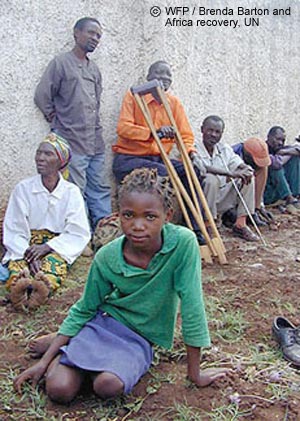|
|  |
| Link to World Vision |

|
Battling the Epidemic with Treatment and Vaccines
HIV/AIDS workers aim to improve access to care and support for people living with the disease in developing countries, in order to do so, an effective preventive vaccine for uninfected people at risk. The challenges in turning these visions into reality require the securing and mobilizing funds and technical assistance from international donors, allocating scant national resources between competing health priorities, and developing or enhancing local systems of care. Effective preventive medical interventions, such as vaccines and microbicides, could supplement prevention efforts; including behaviour change, condom use, and management of sexually transmitted infections, to protect uninfected people.
Treatment of HIV-infected people with antiretroviral drugs and drugs for prevention and treatment of opportunistic infections benefits individuals, communities, and nations. Furthermore, effective HIV care and support can enhance prevention efforts by reducing stigma, increasing rates of uptake of HIV testing, and possibly reducing transmission. Approaches for prevention should be manageable within and adaptable to local conditions. In order to meet these challenges, it is pertinent that public, private, and business sectors participate in efforts to defeat HIV/AIDS in Uganda. Most people in need of care are reliant on the public sector, but are the least able in society to advocate for and access care beyond very basic services. Price reductions have increasingly made antiretroviral drugs attainable for people seeking care in the private sector. Standards of care could be improved with use of models including training, assistance, and incentives for private practitioners to manage large numbers of patients.
|
 |
|
Although there had been more than 45 million cumulative HIV infections in Africa by the end of 2001, there have been only two small, phase I, preventive HIV vaccine trials in the continent most severely affected by the epidemic. HIV vaccines need to be developed for testing in Uganda, and these candidates put through clinical trials leading to large-scale phase III efficacy trials in the continent. Such trials could establish whether candidate vaccines could protect people from HIV infection, or disease, or both, and perhaps also reduce the infectiousness of vaccinated people who do become infected.
|
 |
|
|  |
|
The burden of HIV/AIDS in Uganda demands that enhanced efforts be made to treat large numbers of infected people with antiretroviral drugs while work continues to develop effective preventive vaccines. HIV vaccines will hopefully help to avoid the situation faced with antiretroviral therapy, in which the drugs were initially widely used in only developed countries.

|
| Link to Wold Bank Group |
|
 |
|
|
|
|
The Availability of Drugs
In rural settings such as Uganda, the Availability of drugs is often considered the most important element in quality of health care. Health sector reforms have changed the conditions for managing, supplying, and using drugs through decentralization, user fees, and privatization. Both government and health units compete with, and use, local commercial sources of drugs. However, in light of Ugandas devastating epidemic, there seems to be a need to revise policy. Dialogue and realism are needed in order to create policies that respect both good medical treatment standards and the concerns of frontline workers and their patients. The exercise of rethinking the meaning of drug availability in primary health care calls for methodologies examining the changing context of health care and the evolution of the HIV/AIDS crisis. Consideration for the views of the positions of different categories of actors, at a national and district setting, are required to appreciate gaps existing between drug policy and practice.

|
| AIDS in Uganda |
|
|
|  |

